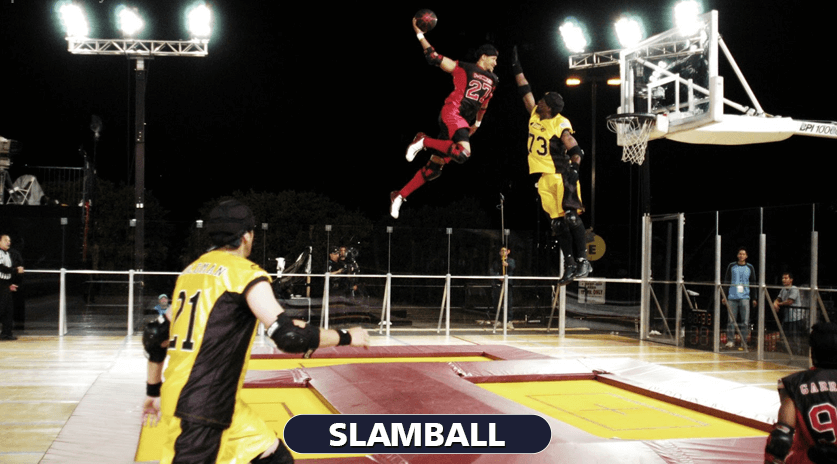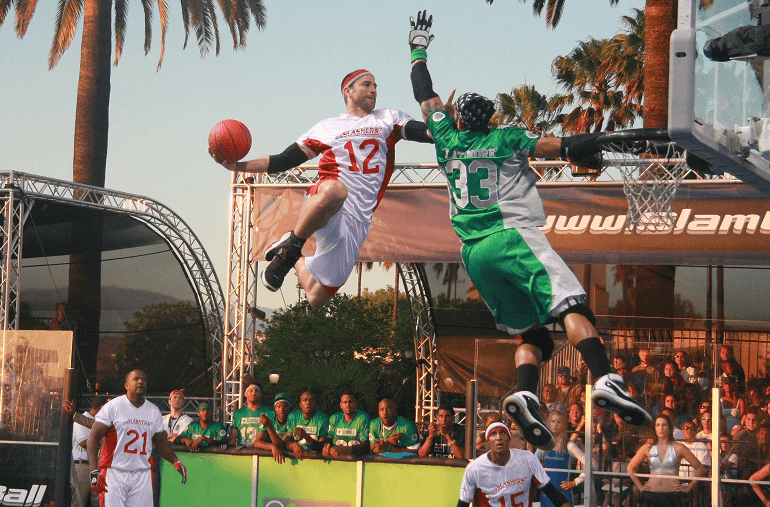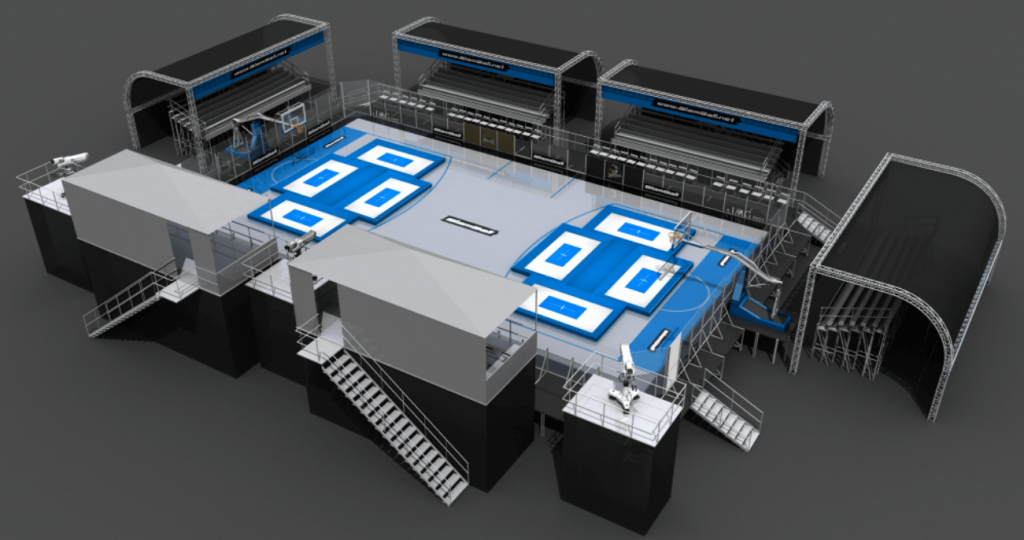

Slamball is a game similar to basketball in that there are two nets, but the similarities end there. In front of each, there are four trampolines. There are also boards around the court edge.
The company Slamball LLC holds the rights to the name of the game. Slamball is a contact sport, with rough physical play, blocks, and collisions a part of it. In this respect, it’s not unlike American football and ice hockey.
History of Slamball
Mason Gordon invented Slamball in 1999. He was working for Tollin/Robbins Productions back then. Drawing inspiration from video games, he sketched the idea on a napkin. The game has elements of several existing ones.
Gordon’s boss Mike Tollin, a film and TV producer, liked the idea and helped fund a prototype court half a year later. It was housed in a warehouse in East LA.
Gordon started looking for players who could crash into each other in the air after jumping off the trampolines without feeling uncomfortable. He turned to the street. He recruited five people for the first games. They comprised the first two Slamball teams: the Los Angeles Rumble and the Chicago Mob. More players joined them after the exhibition series in 2001, which the Chicago Mob won.
400 players within a year
Street basketball players in and around Los Angeles started showing interest in the game, and 400 people were recruited within a year. Gordon held open tryouts and selected players based on athletic ability, awareness, and body control.
The game debuted on TV in 2002. It was featured on what was called The National Network at the time. Today’s it’s the Paramount Network. The first season was played by six teams (the Bouncers, Diablos, Mob, Rumble, Slashers, and Steal).
Reggie Theus, ex-NBA All-Star, was studio co-host and commentator. The new league event was organized by ReelSports. ESPN did a feature on Slamball. It was broadcasted on the British television station Trouble.

Dissolution of the league
The second season was played in 2003. After Turner TV and Mason Gordon had a fight, the league was dissolved. It resurfaced for another season five years later, organizing tryouts, among other things.
Robert Wilson was chosen in the first Slamball draft in 2002 as the first top pick in the sport. A new court was built for the game in Universal City and two expansion teams were added (the Riders and Bandits).
An interactive fan event, the “POWERADE Slamball Challenge”, took place at Hoop City in 2007. It aired on CSTV in April 2007.
Plans for a new season were underway a year later, which would be financed by IMG. Tryouts took place in April 2008 in three cities. For the season, a training camp took place at IMG Academy in Bradenton, Florida. Over a hundred people took part. After an 8-team draft, 64 players were left. The 8 teams were reduced to 6, which is how many there are today.
The first season of the game since 2003 was in the summer of 2008 at Universal Citywalk in Universal Studios. The finals aired on CBS in November 2008.
The Slashers beat the Rumble in the 2008 season championship. The season also aired on Australia’s One HD and Fuel TV.
Rules of the game
You score when you put the ball into the net at the opposing team’s end of the court. At the same time, you must stop your opponent from putting the ball in your net. Whoever scores more points wins. Normally, one “goal” is worth one point. If a player throws the ball through the hoop without touching it, his team gets two points. You’re awarded three for a slam dunk. You also get three points for a shot outside the three-point arc.
At any one team, there can be four players from each team on the court out of 8-10. Players can be replaced at will and during play.
Two referees and the table officials control the game. The latter keep track of the time, score, fouls, team possessions, and the shot clock.
Three positions
The positions are handler, stopper, and gunner. The main ball handler on the team plays offense, controls game flow, and organizes the other members. He is not unlike the point guard in basketball. He is responsible for setting up the gunners to attack the basket while playing offense.
The stopper is the main defense player. He is the shield protecting the net from the opposing team’s gunner. If someone attempts the shot from inside the trampoline space, goaltending is legal.
Finally, the gunner is the main team scorer. He attacks the net and completes plays against the enemy’s stopper, not unlike a wing or forward in hockey or soccer.
Typical team configurations are 1 stopper, 2 handlers, and 1 gunner or 1 stopper, 1 handler, and 2 gunners. Teams are free to choose their own.
Each game has four quarters of 5 minutes. It starts with a “bounce-off”, where you bounce the ball at center court. It ascends to its maximum height uninterrupted, during which players “check” each other.
Half-time is ten minutes. Each team can have one timeout max and they can only use it in the last two minutes of regular play. You use a 15-second shot clock. Teams switch court sides at halftime. When regular time runs out, the team with more points wins. If it’s a tie, the final result is decided via a series of “faceoffs”. More info is available in the fouls section below.
Equipment
Each end is dominated by two sets of four trampolines next to the spring floor. The size of each trampoline is 2.1 by 4.3 m. The panels are shock absorbent, combining with the bed trampolines to launch players very high and cushion their landing at the same time, thereby creating a unique playing surface.
There are special pads covering the frame rails. They feature a unique design guaranteeing maximum safety.
A 2.4 m long plexiglass wall surrounds the court, similar to a hockey rink. Players wear special equipment and protective cups, elbow and knee pads. The helmet is optional and specific to the game.

Fouls
If a player commits more than three personal fouls, he is removed. Players or coaches who argue with officials can be charged with a technical foul. Anyone with more than two technical fouls is disqualified.
The player who commits the foul positions himself on the baseline of the lower trampolines. The one against whom it was committed takes offense position at center court. This is the faceoff. After the referee’s signal, the offensive player tries to attack the basket. The defensive one tries to stop the attack. If he fails and the attack is successful, points will be awarded depending on the shot converted. If it’s a tie, the defensive team takes possession. The other team retains the ball from the center court if the shot was blocked.
Most common
This section contains descriptions of the most common fouls. They result in a faceoff, a turnover, or both.
Fouls resulting in faceoff
- An offensive player has the ball. A defensive player checks him before he’s started dribbling it.
- An offensive player with the ball is checked by a defensive player in the back.
- An offensive player with the ball is checked by a defensive player while trying to enter the trampoline.
- A defensive player stands on an offensive one’s landing spot, purposefully interfering with his bounce and causing the equivalent of a trip in basketball.
Fouls resulting in turnover
- While holding the ball, an offensive player bounces on a trampoline twice.
- Two offensive players bounce or step on the same trampoline.
- Two members of the same team are on the same station.
- An offensive player is on the sides of the trampolines for three seconds or more.
- Someone tries to take a shot from an island.
- Officials can call a charge against the opposite team when the defense holds position on an island.
Foul resulting in faceoff or turnover
When a coach or player uses verbal or physical abuse in an argument with the referee. The referee decides to call a faceoff or turnover.
Slamball outside the US
In 2015, China started building a large number of Slamball facilities after what seemed like an extended courtship with the government. A new partnership was reached with China, and five Slamball teams were created to officially expand the league to Asia. Gordon was instrumental in this process and saw all of his hard work pay off when the game won the Chinese public’s attention and admiration.
Player recruitment
Players are recruited based on a very broad range of criteria due to the specific nature of the game. New League players come from different areas. Athletes have been recruited directly from pro basketball programs and colleges nationwide. Many players are former football players. They are very apt because they are used to the fast, full-contact play style.
The future of Slamball
Admittedly, things have slowed down in recent times, but Gordon has been quoted as saying the sport has never left; it just needs to take the best path.





